Small Business Predictions for 2025
In this episode, Matt Wagner breaks down seven key predictions that will impact Main Street businesses and entrepreneurs in 2025.
Join us for three days of learning, connecting, and celebrating at Main Street Now 2025 in Philadelphia, from April 7 – 9.
Secure Your Spot!
Marion, Iowa © Tasha Sams
We work in collaboration with thousands of local partners and grassroots leaders across the nation who share our commitment to advancing shared prosperity, creating resilient economies, and improving quality of life.

Emporia, Kansas © Emporia Main Street
Made up of small towns, mid-sized communities, and urban commercial districts, the thousands of organizations, individuals, volunteers, and local leaders that make up Main Street America™ represent the broad diversity that makes this country so unique.

Chicago, Illinois © Main Street America
Looking for strategies and tools to support you in your work? Delve into the Main Street Resource Center and explore a wide range of resources including our extensive Knowledge Hub, professional development opportunities, field service offerings, advocacy support, and more!

Waterloo, Iowa © Main Street Waterloo
Your one-stop-shop for all the latest stories, news, events, and opportunities – including grants and funding programs – across Main Street.

Kendall Whittier — Tulsa, Oklahoma © Kendall Whittier Main Street
Join us in our work to advance shared prosperity, create strong economies, and improve quality of life in downtowns and neighborhood commercial districts.

In January, the Main Street America research team launched our latest Main Street Trends Survey focused on understanding the landscape of local Main Street programs operating around the country. The 2023 Trends survey represents the 15th Trends Survey conducted by MSA since 2005, and the first since May of 2021.
We received 367 completed surveys from Main Street leaders in 41 states. To incentivize participation, we decided to offer a free conference registration to one local program leader who submitted a completed survey and to one coordinating program that had at least 50 percent of their accredited and affiliate programs represented. Congratulations to lucky Louisiana, where Winnsboro Main Street in Winnsboro, Louisiana was randomly selected for a free Main Street Now registration, as was the Louisiana Coordinating Program!
We created a series of visualizations and takeaways that summarize the highlights of the 2023 results. A complete version of the results is available here. Do these trends match up with your experiences at the local level?
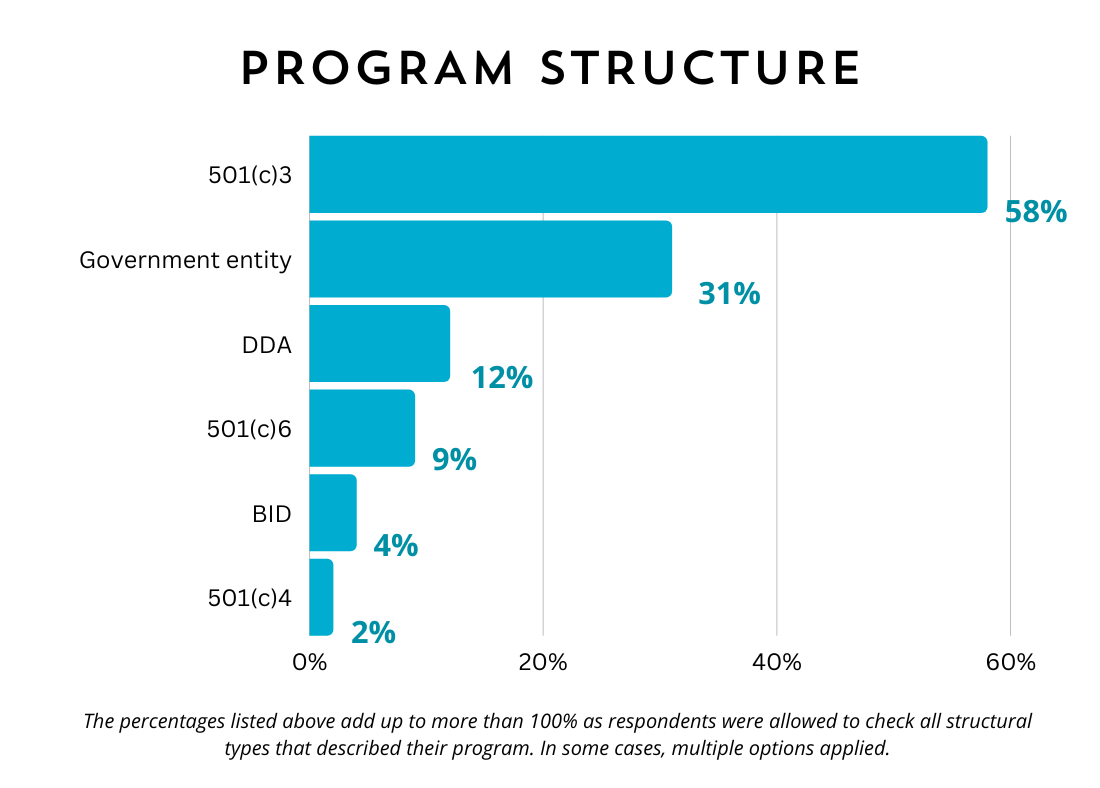
The Trends survey offers the best data available on how local Main Street programs are structured. The 2023 Trends survey data indicates that 58 percent of Main Street programs are 501(c)3 nonprofit organizations. Government entities were the next most common form at 31 percent.
The Trends survey is also the best source of information on local Main Street programs’ annual budgets. In the 2023 Trends survey, we see that programs are roughly evenly distributed in three groups: those with annual budgets of less than $100,000 (31%), between $100,000 and $200,000 (34%), and more than $200,000 (35%). 28 percent of local programs indicated that they have an annual budget between $200,000 and $500,000—the most common response to this question.
Executive directors indicated a diverse variety of sources of funding, including public funding, revenue, grants, and other sources.

We asked Main Street leaders about how programs’ annual budgets have changed over the past two years. In this year’s survey, we see that nearly nine out of ten Main Street programs have stable or growing annual operating budgets. 88 percent of respondents indicated either that their annual budget had stayed about the same or had increased. Only 9 percent said they had their budget had been diminished by 5 percent or more since the previous year.
We find a similar story in terms of the public-private mix of funding in programs’ annual budgets. 78 percent of programs reported either that their public-private balance of funding had not changed since the previous year or that both public and private sources of revenue had increased.
Main Street organizations continue to operate with very few paid staff but many volunteers. Most Main Street programs have one full-time staff person (63%), zero or one part-time staff person (81%), and zero or one temporary staff or contractors (76%). The survey data also indicates that most local organizations (57%) have 20 volunteers or more. Across our survey respondents, local Main Street programs have an average of 46 volunteers who contribute at least 3-5 hours of their time over the course of a year.

56 percent of local Main Street programs pay executive directors annual salaries between $40,000 and $70,000. 21 percent make more than $70,000, and 23 percent make less than $40,000. Highest Executive Director salaries are found in Washington, D.C., where all five Trends survey respondents (100%) earn more than $60,000 per year. Similarly high proportions of EDs earn $60,000 or more in California (80%), North Carolina (72%), and Colorado, Texas, and Washington (60% each).
Four benefits are offered to staff at most responding Main Street organizations: paid vacation and holidays (81%), paid sick leave (69%), professional development budgets and opportunities (66%), and medical insurance (50%). [Interested in seeing more data? The complete set of findings is available here.]
Based on the 367 respondents to the 2023 Trends survey, we can characterize Main Street executive directors in terms of their experience on the job, education, gender, and race and ethnicity.
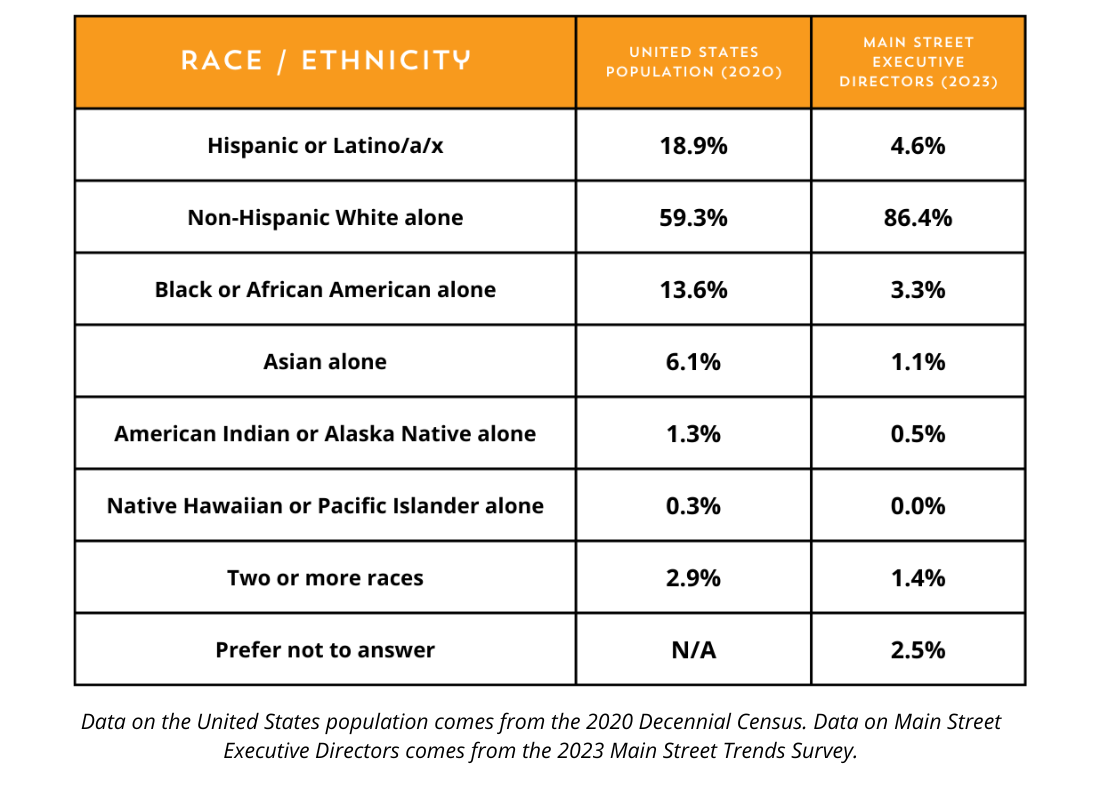 Experience: On average, executive directors have about five years of experience in their current roles, but more than one in five (21%) EDs have been on the job in their current role for less than a year. Close to one in three (31%) have been in their role for less than two years. This may be the result of the COVID-19 pandemic, the “great resignation,” and the incredible pressure on Main Street leaders over the past few years that has led to burnout for many. At the other end of the spectrum, more than one in eight (13%) EDs have been in their role for more than 10 years.
Experience: On average, executive directors have about five years of experience in their current roles, but more than one in five (21%) EDs have been on the job in their current role for less than a year. Close to one in three (31%) have been in their role for less than two years. This may be the result of the COVID-19 pandemic, the “great resignation,” and the incredible pressure on Main Street leaders over the past few years that has led to burnout for many. At the other end of the spectrum, more than one in eight (13%) EDs have been in their role for more than 10 years.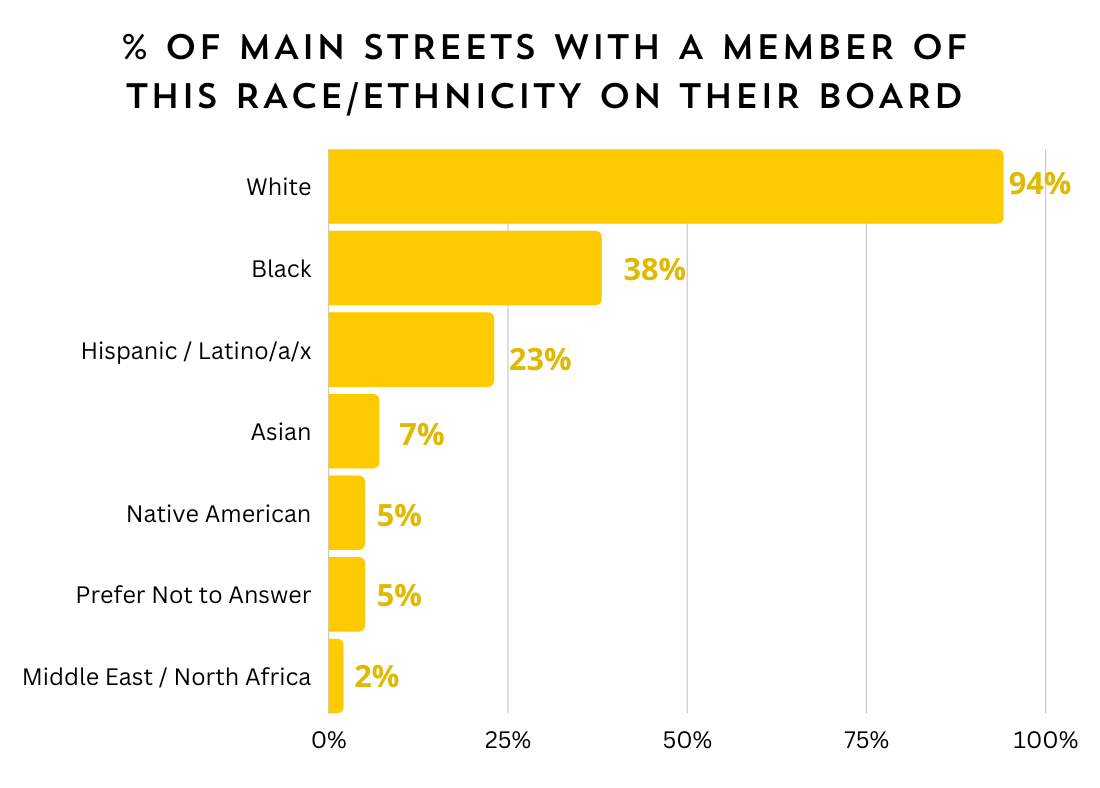
We have been hearing that board engagement is a rising priority for Main Street leaders, so in this year’s Trends survey, we asked about the makeup of local Main Street boards.
In terms of board members’ professional identities and stakeholder communities, we learned that most Main Street boards include business owners or industry representatives (98%), property owners (88%), city officials or elected officials (62%), downtown / district residents (62%), and senior citizens and retired people (59%). Non-native English speakers (9%), people with disabilities (8%), young people under the age of 18 (4%) are the three groups that are least well represented.
Meanwhile, we see much greater racial and ethnic diversity on Main Street boards in comparison to the racial and ethnic diversity of Main Street executive directors. 94 percent of respondents indicated that they have at least one White or Caucasian board member. Many Main Street boards include Black or African American board members (38%) and Hispanic or Latino/a/x board members (23%).
Multiple questions on the 2023 Trends survey focused on diversity, equity, inclusion, and accessibility (DEIA). These questions emerge from Main Street America’s commitment to advance DEIA in all our work and to grow a broader and more inclusive Main Street movement (as detailed in our strategic plan).
About 70 percent of survey respondents indicated they either somewhat agreed or strongly agreed that “improving the diversity, equity, inclusion, and accessibility of my program’s patrons, constituents, and programming is a priority in 2023.” Only 10 percent indicated disagreement with that statement. In the 2021 Trend Survey, 60 percent of respondents indicated that they had no goals or priorities related to diversity, equity, and inclusion. This growth in DEIA priorities is exciting.
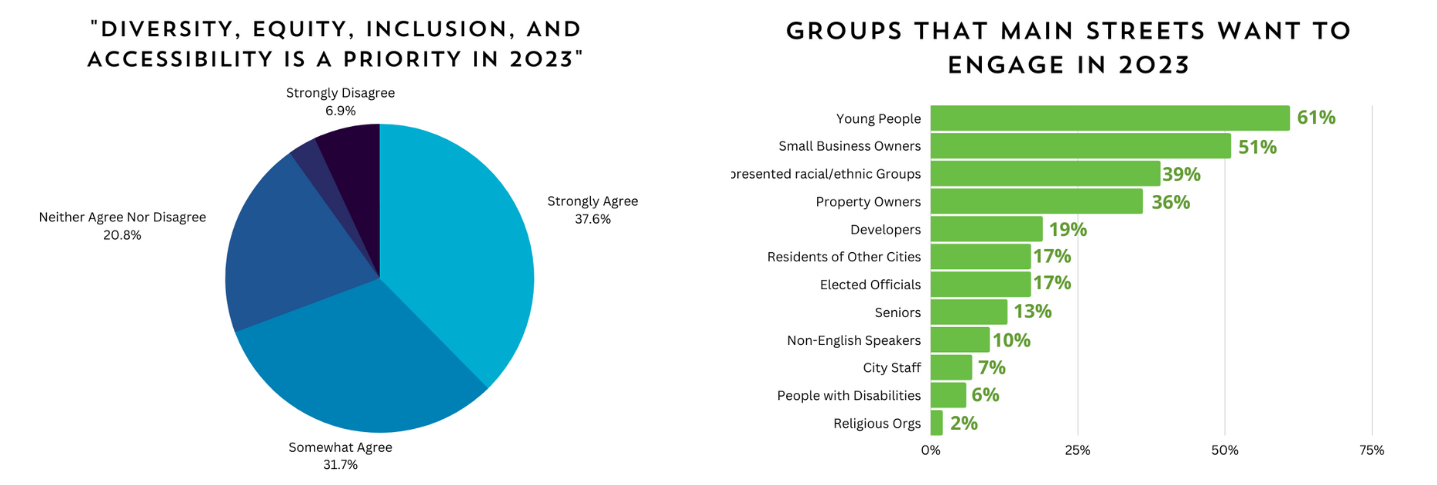
We asked executive directors what groups they hoped to engage with more deeply in 2023. 61 percent of Main Street leaders indicated that youth and young people are a priority. Small business owners (51%) and property owners (36%) were frequently cited as priority groups. Engagement with underrepresented racial or ethnic groups is a priority for 39 percent of respondents.
To support deeper engagement with these groups, we asked what resources, trainings, and tools would be most helpful. 71 percent of Main Street executive directors indicated that training on how to best market to, attract, and engage with new groups would be useful. A peer-to-peer network with other Main Street programs with similar priorities (48%) and economic data about consumer spending (48%) were also cited as potentially useful resources for supporting engagement.
We also asked what the three most effective ways to market Main Street programs and their activities. Unsurprisingly, social media was cited by 94 percent of respondents as one of the top three marketing channels and by 78 percent as the single most effective channel for marketing. Program websites were the next most popularly cited marketing channel (57%). Print media also seems to be sneakily popular, as 39 percent of respondents cited it as one of their three most effective ways to market their program.
.png)
District Challenges and Program Strengths and Opportunities
In the survey’s final section, we asked about the top three challenges in the executive directors’ downtowns and neighborhood commercial districts, as well as the top three program successes in 2022 and top three areas for improved impact in 2023.
Survey respondents identified a wide spectrum of challenges in their downtowns and neighborhood commercial districts. Inconsistent or limited store hours (38%) and challenges with building maintenance and poor building condition (36%) were the two most often cited. Five other challenges were cited by at least one-fifth of the respondents, including business variety (28%), shortage of commercial spaces or storefronts (26%), challenges with infrastructure (24%), a shortage of housing (23%), and the affordability of commercial spaces and storefronts (20%).

Executive directors shared their pride in local programs’ greatest successes from 2022. Planning and hosting successful and popular events was more often cited than any other success by a wide margin (59%). Local programs touted their successful support of existing businesses (40%) and their support for placemaking and public art (25%). Beyond these top three successes, the survey results indicate a diversity of successes, but notably, diversifying the composition of programs’ boards (8%); supporting diversity, equity, inclusion, and accessibility (6%); supporting housing development (5%); and maintaining or improving the Executive Director’s own work-life balance (5%) were least often cited.
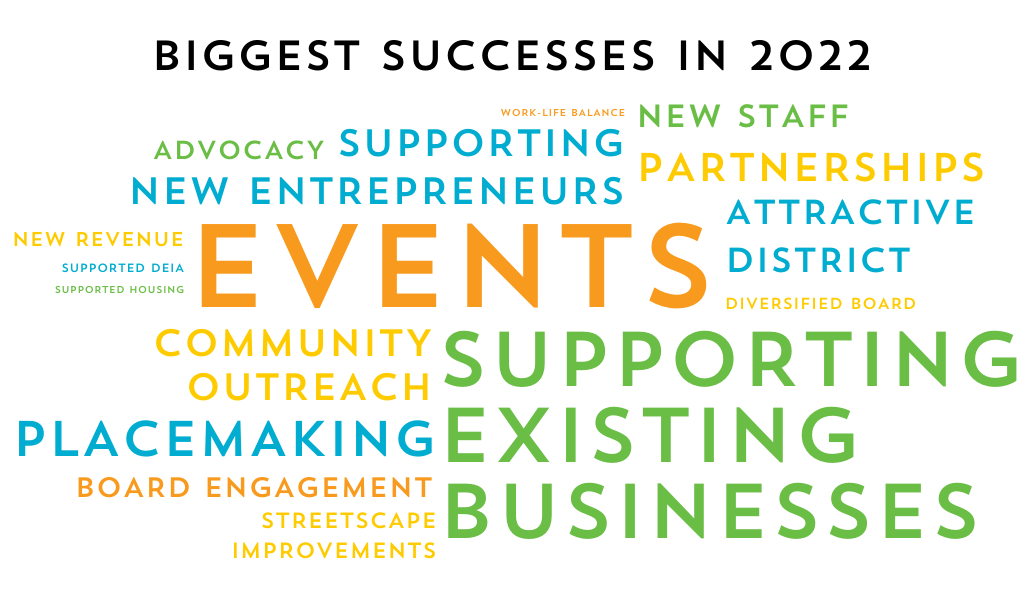
Since we launched this survey at the start of 2023, we were excited to hear from executive directors about the areas they were striving to improve their impact in the year ahead. Strengthening board engagement, noted as a top 2022 success by 14 percent of respondents on the prior question, was a top priority for 32 percent of respondents as they looked forward into 2023. Conducting successful community outreach and building community buy-in, noted as a 2022 success by 19 percent on the prior question, was a top priority for 31 percent of executive directors making plans for 2023. Housing development and support for DEIA also notably jump from lower rates of touted success in 2022 (as noted above) to higher priorities in 2023.
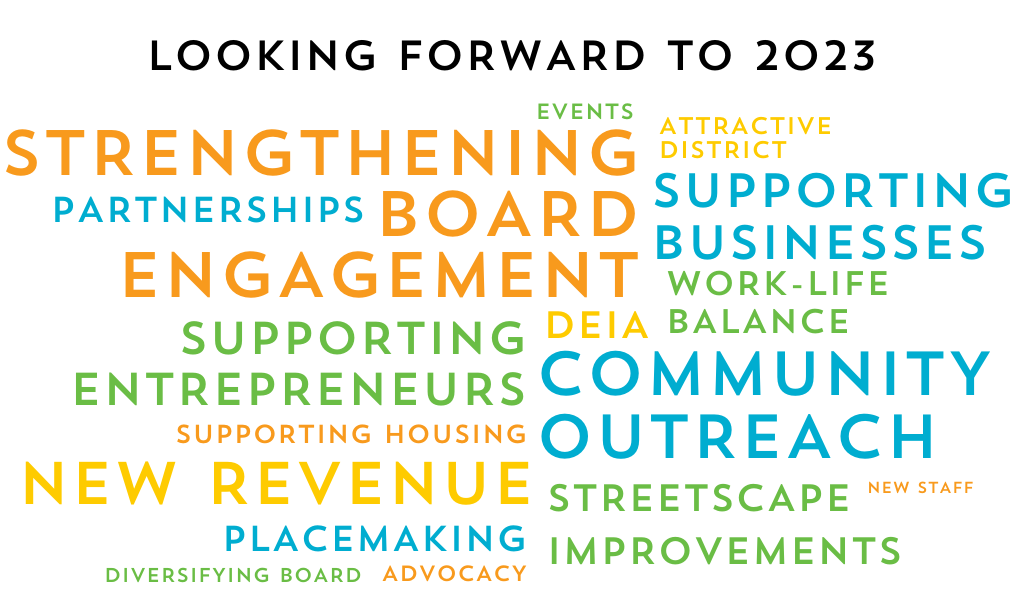
To see how the Main Street in your state compare to other states, check out this interactive map of survey results >
Clearly, the results of the 2023 Trends survey provide a lot of interesting insights into the actors and activities animating Main Street districts across the country. We appreciate the hundreds of executive directors who took time out of their busy schedules to respond to these questions. If the lengthy summary of the results provided in this blog post are only just starting to whet your appetite, you can see a complete PDF of the survey results here.
If you enjoyed reading through these findings, we are excited to have more data to report on soon. This week, we are kicking off our Winter 2023 Small Business Survey, and we need your help getting the word out. We would love to hear from small business owners and entrepreneurs in your downtowns, neighborhood commercial districts, and communities. Please be on the lookout for the survey link and distribution materials in upcoming editions of Main Street News. Thank you!